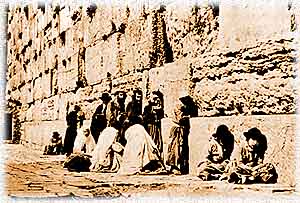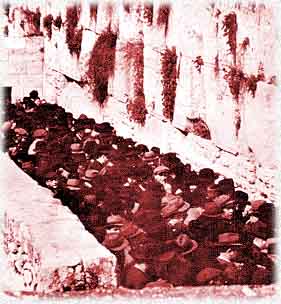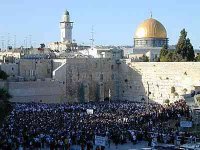
Research
Menu
The
Wailing
Wall
Western Wall Temple
Mount in Jerusalem

History
History
For
500
years, until the Muslims captured Jerusalem, this whole southwest area,
where the Wailing Wall (the Kotel) was known as a garbage dump . The
women
of the new Roman city built over the ruins of Jerusalem were
instructed,
by Roman law, to take their garbage to the dump daily (wall of the old
Temple site). The Byzantines, from their capitol in
Constantinople,
held on to Palestine until 614 AD.
Muslim armies swept through
Palestine
and at the end of the summer in the year 636 AD, following the Battle
of
Yarmuk, the outcome of which signaled the end of the Byzantine period
in
Palestine, the Muslims made for Jerusalem and laid siege to the city
for
two years. After eighteen months the besieging army was joined by a
second
force, led by ben-Jarah, and finally the city surrendered. Records show
that Omar, the second caliph of Islam who captured Jerusalem in 636 AD,
decided to build a mosque to worship Allah on the southern end of the
Temple
Mount, and the construction of the wooden mosque began on that spot.
The Ottoman ruler Sultan
Suleiman,
in the second half of the sixteenth century, finally gave the Jews full
exclusive rights to the Kotel as a Jewish holy place of worship once a
year on the 9th of Av. The prayer area was established along a 68 foot
section of the wall with a width of around 10 feet, which was closed
off
by a wall running parallel to the Kotel. The area was paved and this
small
enclosure was the sacred prayer site of the Jewish people, and a place
to mourn the destruction of the Temples. But during that first 500
years
after the destruction of the Temple in 70 AD there were many years that
the Jews were allowed to return once a year to mourn. It is not a
coincidence that they chose to worship at the southern end of the
Temple
Mount at the western wall. Many believe that the Temple was located at
the Dome of the Rock or even further north, but if that were the case
the
Jews would have worshiped at a more northern location of the wall all
along,
but it has always been the site of the kotel of today. This
tradition
of returning once a year to mourn the destruction of the Temple began
while
those that lived during the destruction were still alive and the
tradition
continued with their children and grandchildren, the knowledge passed
down
through the generations.

Under Turkish rule in the 16th century

The Jewish mourners jambed into this small area in 1945.
In 1967 The Jewish army captured Jerusalem. After the Six day War
the
buildings placed against the Kotel were removed and the entire area in
front of it was cleared, levelled and converted into a large paved open
space. The area was partitioned off; one third is reserved for women
and
two thirds for men. The Kotel once more became a place of pilgrimage
and
prayer for Jews from all over the world.

On the first day of Shavuot after the Six Day War, a quarter of
a million Jews swarmed to the Wall,
for the first time in 20 years.
New additions not in videos
Locating
Solomon's Temple
by Norma Robertson
NOW ON VIDEO!
BOOK
"Locating
Solomon's Temple"
by Norma Robertson
|








